Servicios Personalizados
Revista
Articulo
Indicadores
-
 Citado por SciELO
Citado por SciELO
Links relacionados
-
 Similares en
SciELO
Similares en
SciELO
Compartir
Latin American applied research
versión impresa ISSN 0327-0793
Lat. Am. appl. res. v.35 n.3 Bahía Blanca jul./sept. 2005
Experimental determination of the influence of turbulent scale on the lift and drag coefficients of low Reynolds number airfoils
J. S. Delnero, J. Marañon di Leo, F. A. Bacchi, J. Colman and U. Boldes
Laboratorio de Capa Límite y Fluidodinámica Ambiental, Departamento de Aeronáutica,
Facultad de Ingeniería, Universidad Nacional de La Plata. , Calle 48 y 116, La Plata (1900), Argentina
Abstract — Boundary layer wind tunnel experiments have been conducted in order to expose aspects of a turbulence scale dependent behaviour of two low Reynolds number airfoils: - Selig 4083 and Selig-Donovan 7037. The airfoils were submitted to two different turbulent flows with the same mean velocity but different turbulence structures. In one of the flows large eddies prevail while the other flow was primarily shaped by small scale eddies. Lift and drag coefficients were calculated and plotted. These values were contrasted with laminar flow wind tunnel data obtained from previous experiments made at the University of Illinois, at Urbana Champaign, by the Experimental Aerodynamic Group led by Michael Selig.
Keywords — Aerodynamics. Turbulence. Low Reynolds Number Airfoils.
I. INTRODUCTION
The performance of airfoils operating at low speeds and particularly low Reynolds airfoils has been a topic of increasing attention during the last decade. This interest was a consequence of a search for improving aircraft low speed performance as well as to improve the design of wind turbine blades, jet engine fan blades, rotors, and propellers.
The atmospheric surface layer in which important flight operations take place is characterized by very different, complex instantaneous local wind profiles with strong gusts. These intricate velocity flows are usually originated by wind deviations and eddies produced by the interaction of the natural wind with plants, topographic features, and constructions. Particular air density variations due to temperature and humidity distributions causing unstable thermal stratification, can also trigger the generation of violent gusts. The majority of the previous experimental studies on airfoils were concentrated on boundary layer aspects and the lift and drag outcome, disregarding the analysis of the turbulent structure of the oncoming flow, the wake flow structure and the evolution of vortex shedding processes.
The local velocities felt by a wing section are a result of the vectorial addition of the airplane velocity with the mentioned atmospheric velocities and attitude changes producing lateral or vertical slip, and airplane rotations generating pitching, yawing, and rolling motions.
The influence of turbulence on the resulting flow patterns around wing sections depends among other factors, on the relation between airplane mean velocity to atmospheric turbulent velocities.
The slower an airplane flights the larger will be the instantaneous incident wind directional and intensity variations due to turbulent gusts. The turbulence induced flow perturbations around an airfoil influences the occurrence of attached flows, unsteady disordered separated flows, and vortex generation. Representative wind tunnel experiments should reproduce the main turbulent characteristics of the regions in which a particular airplane is expected to operate.
Stack (1931) performed one of the first experiments investigating effects of scale and turbulence in 1931, at the NASA-Langley Memorial Aeronautical Laboratory. Turbulence was generated by suitable grids. Unfortunately at that time the scale and intensity of turbulence were not measured due to the inexistence of reliable instruments. Over the years, the experimental study of turbulent structure effects on airfoil characteristics was scarce.
General aspects of the scenario involving dynamic separation and reattachment on airfoils have been treated by Green and Galbraith (1996).
Turbulent gusts as well as fast pitching motions can generate rapid angle of attack variations. With adequate caution, some oscillating airfoil experimental information may be applied to reveal aspects of the aerodynamics of non pitching wings in a turbulent flow environment.
As far as the authors know most of the previous experimental studies about oscillating airfoils as those performed by (e.g. Carr et al., 1977; Leishman, 1990), were concentrated on pitching airfoils disregarding the influence of turbulent scale in the oncoming flow.
Studies of an airfoil submitted to oscillating and translating motion in low Reynolds number conditions were presented by Ohmi et al. (1990 and 1991).
Fluctuating angle of attack of the oncoming velocity can promote the beginning of localized airfoil stall followed in some cases by the reattachment of the flow. Incipient dynamic stall phenomena have been treated by Gracey et al. (1996 and 1997) who developed a interesting methodology for the prediction of such unsteady stall phenomena.
Important experimental studies on vortex shedding and shear-layer instability in the low-Reynolds number flow over a symmetrical airfoil have been presented by Huang and Lin (1995) and Huang and Lee (2000).
The onset of vortex shedding and its particular evolution were found to be closely related to the boundary layer behavior, the shear-layer instability, the free stream conditions and the angle of attack.
Separation and reattachment processes involve generation and interaction of shear layers. It is known that turbulent shear flows are very sensitive to small changes in initial or boundary conditions and to different types of upwind, downwind and separation point perturbations applied during transition (Cantwell, 1981; Oster and Wygnanski, 1982). Thus, a particular airfoil sensibility to specific characteristics of flow and environmental perturbations should be expected. Exploring this perception Green and Galbraith (1994) demonstrated aspects of the effect of the testing environment on unsteady aerodynamical experiments. Numerous experimental studies have also shown the significant effects of particular external perturbations on airfoil performance. If these perturbations are able to induce flow variations at an appropriate frequency, then significant boundary layer separation phenomena may be controlled allowing improvements in airfoil performance (Mueller and Batill, 1982; Zaman 1992). The unsteady mechanisms that might produce these effects are still obscure. By way of illustration, the discrepancies of experimental and numerical results shown by McGhee et al. (1988), confirm the complexity of these phenomena. More recently Swalwell et al. (2003) investigated experimentally effects of turbulence intensity generated by different grids on the stall of a thick NACA 4421 airfoil section with an aspect ratio greater than seven, for angles of attack ranging from -90o to +90o, at a Reynolds number of 2.85×105. The realism of this turbulence generation is questionable because grid generated turbulence is quite different from the turbulence within the atmospheric surface layer. Conventional aerodynamic theory is still not capable of predicting the real forces generated by wings submitted to brusque variations of angle of attack. It has been recognized for many years that the maximum lifting force generated by a wing compelled to rapid pitching motion can be substantially enhanced. These conditions may occur in rapidly maneuvering aircraft, flapping wings, wind turbines in gusty wind, flight operations in turbulent environment or flying through the wake of other airplanes. It has been learned that when an airfoil is submitted to rapidly increasing angles of attack above the stationary separation point a strong vortex, located on the suction surface is usually generated. This vortex is called dynamic stall vortex. After growing to a given size, this eddy may be shed downstream into the wake flow. Typically the lift increases with increasing vortex intensity. As long as the vortex remains close to the upper surface of an airfoil a substantial lift increase occurs, which decreases rapidly as the vortex flows away. The basics of this dynamic stall process have been described by McCroskey (1982), Carr et al., (1977) and Carr (1985). The limitations of the existing methodologies for predicting, calculating and describing the time dependent location and nature of separated regions induce the unavoidably requirement of experimental work. The present experiments were performed in order to contribute to the understanding of turbulent scale dependent effects on the behaviour of low Reynolds number airfoils and to present data against which airfoil prediction methodologies can be tested.

Figure 1. Wind Tunnel wing deflector distribution: (a) Turbulence A and (b) Turbulence B.
II. EXPERIMENTAL DETAILS
The experiments were carried out at the Boundary Layer and Environmental Fluid Dynamics Laboratory (LACLYFA) at the Faculty of Engineering at the Universidad Nacional de La Plata, Argentina.
The wind tunnel equipped with an electronic speed control which allows speeds between 10 Km/h to 70 Km/h was described in Boldes et al., (1995). It is a closed section tunnel with a width of 1.40 m and a height 1 m and a length to height ratio of 7,2, powered by a 50 HP cc electric motor with an axial flow, variable velocity adjustable pitch blade propeller. The turbulence was not generated by grids as previous works Swalwell et al. (2003).
Special care was devoted in selecting turbulence generation procedures as close as possible to natural atmospheric mechanisms, according modern boundary layer wind tunnel technique.
At the entrance of the test section background turbulence was generated by means of an array of vertical distributed equally spaced horizontal airfoils, inducing different vertical deflections of the flow as shown in Fig. 1. Each airfoil could be individually rotated 360 degrees around its longitudinal axis.
Subsequently the flow was processed by an arrangement of spires placed at the bottom followed by a floor distribution of roughness elements of two different sizes along the 7.2 meters long working section shown in Fig. 2.
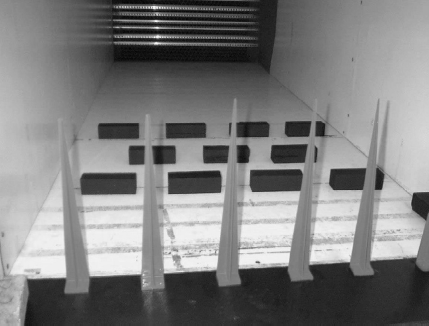
Figure 2. Downstream view of the wind tunnel test section showing the triangular mixing spikes and the roughness elements.

Figure 3. View of a wing section attached to the balance.
The goal was the achievement of two different oncoming flows with the same mean velocity acting on the airfoils but with turbulence structures of two different scales. Consequently, for each turbulence an adequate distribution of rotation angles of the airfoils were selected, as well as a adequate floor distribution of roughness elements
Thus, two type of turbulences are obtained: large and small scale turbulences from now on called A and B turbulences, respectively.
The reference mean velocity U was measured by means of a portable DANTEC Flow Master hot wire anemometer equipped with a 5m long telescopic arm at a central point 100-cm upstream from the tested wing section and 50 cm above the wind tunnel floor. The tests were conducted at a reference mean velocity 6,7m/seg corresponding to a Reynolds number of 2.02×105.
Reynolds number calculation was based on the reference free mean velocity and the airfoil chord.
For each flow the wing sections were examined within the range of angles of attack -10o £ θ £ +24o.

Figure 4. Mean velocity distribution for all turbulent flows.
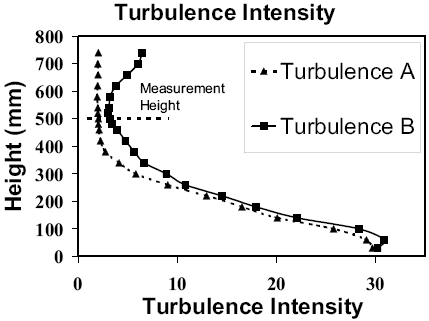
Figure 5. Turbulence Intensity Distribution of the horizontal wind component.
The experiments were repeated for the two types of turbulent flows and for the mentioned two reference mean velocities. The present experiments examine the lift and drag behaviour of two well known low Reynolds number airfoils: the Selig 4083 and the Selig-Donovan 7037.
Turbulent velocities were acquired by means of a six channel Dantec Streamline constant temperature anemometer. The test section dimensions were 7,5 m length with a width of 1.40m and a height of 1m..
The aerodynamic balance (Fig. 3) built by the authors according Tusche (1984) is based on strain gage type cells, arranged as a double Wheatstone bridge acquiring simultaneously data of horizontal and vertical loads.
The incoming data is processed by Vishay series 2310 signal conditioners and amplifiers.
The wind tunnel results will be contrasted with the laminar flow results displayed in the Lyon et al. (1995). According to the mentioned sensibility to environmental perturbations detailed by Green and Galbraith (1994), the authors strongly suggest the validation of the present results with full-scale flight experiments.
The authors selected these low Reynolds airfoils due to their extended application in gliders, and light aircraft. Model wings were built for each airfoil, with a span of 80 cm and a chord of 45 cm. Each wing section was horizontally placed in the test section as shown in Fig. 3. Due to the minimal frontal area of the wing sections, no blockage correction were applied to the results.
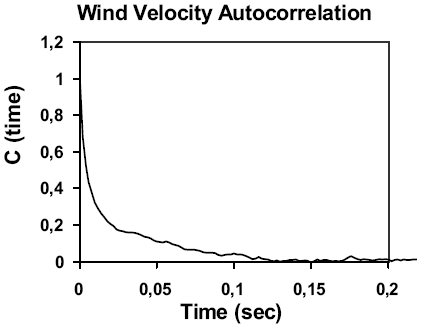
Figure 6. Horizontal wind velocity autocorrelation - Turbulence A.
The section lift coefficient (CL) and the section drag coefficient (Cd) were measured for both turbulent flows and plotted as a function of the Reynolds number (Re) and the angle of attack θ. The lift and drag coefficients were corrected for wind tunnel wall and wing tip effects. Temperature was continuously measured in order to adjust the air density.

Figure 7. Horizontal wind velocity autocorrelation - Turbulence B.
Figure 8a. Wavelet transformation. Turbulence A.
Figure. 8b. Wavelet transformation. Turbulence B.
III. RESULTS
The study was exposed in three steps:
a) Generation of two velocity profiles with the same mean velocity but different turbulences.
b) Construction of the models and implementation of the wind tunnel experiments.
c) Processing the experimental data, and evaluating the influence of turbulence scale by comparing these results with laminar flow wind tunnel data. (Lyon et al., 1995).
Mean velocity and turbulence intensity distributions were calculated and shown in Fig. 4 and 5.
The autocorrelation for the horizontal velocity component shown in Fig. 6 and 7 clearly indicates the scale differences for both types of turbulences.
It is known that the continuous wavelet transform is appropriate for describing turbulent structure characteristics in turbulence flow data (Farge, 1992).
Aspects of the turbulent scales of the embedded flow structures could be clearly appreciated in the wavelet analysis of the horizontal velocity component shown in Fig. 8a and 8b.
The measured CL versus θ evolution displayed in Fig. 9 and 10 were compared with laminar flow data obtained by Lyon et al. (1995) shown as a continuous curve. The behaviour for the A and B turbulences are represented as a thin dashed curve and a thick dashed curve respectively.

Figure 9. CL versus angle of attack Distribution.
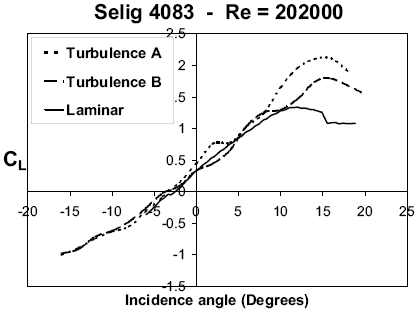
Figure 10. CL versus angle of attack Distribution.
Figures 11 and a12 shows the lift to drag behaviour for both wing sections.
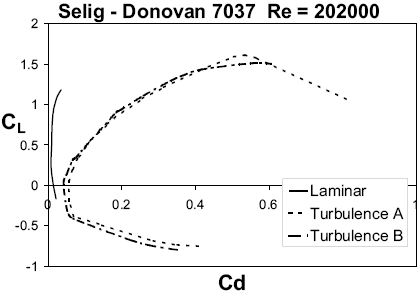
Figure 11. Selig-Donovan 7037 CL versus Cd Distribution.

Figure 12. Selig 4083 CL versus Cd Distribution.
IV. DISCUSSION
It was interesting to verify that for both types of turbulence, from zero angle of attack up to moderate angles of attack, the CL/θ slopes agree with the slopes for the laminar case shown in Lyon et al. (1995).
The stall angle increase for both turbulent flows was significant in comparison to the corresponding to laminar flow.
This already known behaviour is attributed to the ability of turbulent boundary layers in overcoming larger adverse pressure gradients retarding flow separation.
The different stall behaviour for the two types of turbulences should be noted.
For both wing sections the maximum section lift coefficient Cl for the large scale turbulence A was always larger than for the small scale turbulence B.
On the other hand, for both wing sections the small scale turbulence B, shows a smoother and more controllable behaviour in the stall region. It is important to draw attention to the fact that the stall angle is always larger for flows with small scale turbulence than for larger turbulent scales.
These behaviours suggest that at stall conditions the large scale turbulence is more capable in inducing local boundary layer separations which roll-up into strong lift generating vortices. After developing these vortices may drift downstream into the wake promoting significant lift and drag variations.
On the other hand it was interesting to find significant differences in the CL versus CD behaviour between the two airfoils at stall conditions. While the lift to drag ratio of the 7037 airfoil was not very sensitive to the two different turbulent scales, the 4083 airfoil showed a better behaviour for the large scale turbulence.
The aerodynamic efficiency of the two wing sections appears related to turbulent scale and airfoil shape. The present results suggest the convenience of going forward in experimental work about the turbulent structure behaviour of airfoils and that that turbulent scale should be considered in predictive models of airfoil performance.
ACKNOWLEDGEMENTS
The authors are gratefully for the support of the Aeronautical Department and the Boundary Layer Wind Tunnel Laboratory at the Faculty of Engineering, at the Universidad Nacional de La Plata, Argentina.
REFERENCES
1. Boldes, U., J. Colman and V. Nadal Mora, "The Boundary Layer Wind Tunnel at the Faculty of Engineering, University of La Plata, Argentina", Latin American Applied Research, 25, 75-85. (1995). [ Links ]
2. Cantwel, B.J., "Organized motion in turbulent flow", Annual Review of Fluid Mechanics, 13, 457-515 (1981). [ Links ]
3. Carr, L.W., K.W. McAlister and W.J. McCroskey, "Analysis of the development of dynamic stall based on oscillating airfoil experiments", NASA TN D-8382 (1977). [ Links ]
4. Carr, L.W., "Dynamic stall - Progress in analysis and prediction", AIAA Atmospheric Flight Mechanics Conference Paper no. 85-1769-CP (1985). [ Links ]
5. Farge, M., "Wavelet Transforms and their applications to Turbulence", Annual Rev. Fluid Mechanics, 24, 395-457 (1992). [ Links ]
6. Gracey, M.W., A.J. Niven, F.N. Coton, R.A.McD. Galbraith and D. Jiang, "A correlation indicating incipient dynamic stall", Aeronautical Journal, 100, 305-311 (1996). [ Links ]
7. Gracey, M.W., F.N. Coton and R.A.McD. Galbraith, "On the prediction of unsteady stall criticality", Aeronautical Journal, 101, 525-532 (1997). [ Links ]
8. Green, R.B., and R.A.McD. Galbraith, "A demonstration of the effect of the testing environment on unsteady aerodynamical experiments", Aeronautical Journal, 98, 83-90 (1994). [ Links ]
9. Green, R.B., and R.A.McD. Galbraith, "Comment on dynamic airfoil flow separation and reattachment", Journal of Aircraft, 33, 1211-1216 (1996). [ Links ]
10. Huang, R.F. and Lin, C.L. "Vortex shedding and shear layer instability of a wing at low-Reynolds numbers", AIAA Journal, 33, 1398-1430 (1995). [ Links ]
11. Huang, R.F. and H.W. Lee, "Turbulence effect on frequency characteristics of unsteady motions in the wake of a wing", AIAA Journal, 38, 87-94 (2000). [ Links ]
12. Leishman, J.G., "Dynamic stall experiments on the NACA 23012 aerofoil", Experiments in Fluids, 9 49-58 (1990). [ Links ]
13. Lyon, C., P. Broeren, A. Giguere and G.M. Selig. (1995). Summary of Low-Speed Airfoil Data, Vol. 1, 2 and 3 (1995). [ Links ]
14. McCroskey, W.J., "Unsteady Airfoils", Annual Review of Fluid Mechanics, 14, 285-311 (1982). [ Links ]
15. McGhee, R.J., B.S. Walker and B.F. Millard, "Experimental results for the Eppler 387 airfoil at low Reynolds numbers in the Langley low-turbulence pressure tunnel", NASA TM-4062, 228 (1988). [ Links ]
16. Mueller, T.J. and S.M. Batill, "Experimental studies of separation on a two-dimensional airfoil at low Reynolds numbers", AIAA Journal, 20, 457-464 (1982). [ Links ]
17. Ohmi, K., M. Coutanceau, Ta Phouc Loc and A. Dulieu, "Vortex formation around an oscillating and translating airfoil at large incidences", J. Fluid Mech., 211, 37-60 (1990). [ Links ]
18. Ohmi, K., M. Coutanceau, O. Daube and Ta Phuoc Loc, "Further experiments on vortex formation around an oscillating and translating airfoil at large incidences", J. Fluid Mech., 225, 607-630 (1991). [ Links ]
19. Oster, D. and I. Wygnanski, "The forced mixing layer between parallel streams", Journal of Fluid Mechanics, 123; 91-130 (1982). [ Links ]
20. Stack, J., Tests in the Variable Density Wind Tunnel to Investigate the Effects of Scale and Turbulence on Airfoil Characteristics, NACA Langley Memorial Aeronautical Laboratory, 43 (1931). [ Links ]
21. Swalwell, K.E., J. Sheridan and W.H. Melbourne, "The effect of turbulence scale and intensity on stall of a NACA 4421 airfoil", Proceedings of the. Eleventh International Conference on Wind Engineering, Lubbock, Texas, June 2-5, 1959-1966 (2003). [ Links ]
22. Tusche, S., Interner Bericht: Beschreibung des Konstruktiven Aufbaus und Kalibrierung von 6 - Komponenten - DMS - Windkanalwaagen. Deutsche Forschungs - und Versuchsanstalt fur Luft - und Raumfahrt. Hauptabteilung Windkanale Braunnschweig Gottingen Koln-Porz. (1984). [ Links ]
23. Zaman, K.B.M.Q., "Effect of acoustic excitation on stalled flows over an airfoil", AIAA Journal, 30, 1492-1499 (1992). [ Links ]














